|
 QUICKLOOK BYPASSED PAY ANALYSIS
QUICKLOOK BYPASSED PAY ANALYSIS
Bypassed pay
zones, especially oil plays, are an important target for log
analysts. Tight gas and other unconventional reservoirs are also
discovered by the same techniques as are used for bypassed pay.
By going back to basics, there is a good chance that scanning a
reasonably large number of wells with a logical approach will
discover something that was overlooked.
Before looking at the method, we
should define net pay. Net pay is an interval that can produce
economically at today's prices, today's costs, and with today's
technology. What was uneconomic 25 years ago may be economic
today. Zones incapable of production just 10 years ago can now
be economic with horizontal wells and current hydraulic
fracturing technology.
How can you be the first to find
these bypassed zones? The basic technique is called the
resistivity porosity overlay, which has been widely used for 50
years as a quicklook log analysis technique. By quantifying the
approach in a petrophysical software package, it lends itself to
recon style analysis. This helps reduce eyestrain looking at all
those old raster image logs. It eliminates judgment fatique by
normalizing all those variable log scales and sensitivities.
 QUICKLOOK VISUAL ANALYSIS
QUICKLOOK VISUAL ANALYSIS
Most people
working in the oil industry just want to "look" at a log and
understand what the reservoir is all about. Even after years of
experience, this is difficult, especially when working on new or
unfamiliar areas. That's why specialists use fancy software and
take hours or days to generate results for the rest of the
exploitation team.
However, there are things you can
do using your eyes and your logical brain power to gain some
understanding without the calculator or the computer.
Lets
start with just 3 curves - the gamma ray (GR), resistivity, and
a porosity indicating log (a sonic log in this case) as shown in
the image below. The GR is
at the far left and the sonic is the left edge of the red
shading. The resistivity and sonic have been overlaid to make it
easier to see the shape of the two curves relative to each
other.
 Basic Rule
"A": When GR (or SP) deflect to the left the zone is clean and
might be a reservoir quality rock. When GR deflects to the
right, the zone is usually shale (not a reservoir quality rock).
There are exceptions to this rule, of course. Basic Rule
"A": When GR (or SP) deflect to the left the zone is clean and
might be a reservoir quality rock. When GR deflects to the
right, the zone is usually shale (not a reservoir quality rock).
There are exceptions to this rule, of course.
Basic Rule "B": Porosity logs are
scaled to show higher porosity to the left and lower porosity to
the right. Clean and porous is good, so compare the GR to the
porosity log and mark clean+porous zones.
Basic Rule "C": Resistivity logs
are scaled to show higher resistivity toward the right. Higher
resistivities mean hydrocarbons or low porosity. Low resistivity
means shale or water zones. So clean+porous+high resistivity are
good. There are exceptions to this rule too.
Schematic drawing of a
resistivity-porosity overlay, showing the variety of rocks that
can show separation between the porosity and resistivity. Note
that the two curves "track" each other in water and non-source
shales. 
The exceptions are what makes the
job interesting. There are low resistivity pay zones,
radioactive (high GR) pay zones, gas shales, oil shales, coal
bed methane, and low porosity zones that produce for years. Some
of these are shown in the illustration. See if you can figure
out the
logic behind each of the interpretations shown here before you
move on to the more formal rules.
The resistivity-porosity overlay has been in use since about
1962 when the first sonic logs showed up, concurrent with the
beginning of the logarithmic scale for resistivity log displays.
The overlay is created by tracing
or "overlaying" the deep resistivity curve (on a logarithmic
scale) on top of a porosity log (sonic, density, or neutron),
and shifting the resistivity log sideways until it lines up with
the porosity curve in an "obvious" water zone. That means that
the lowest resistivity values sit on top of the porosity curve
and higher resistivity values fall to the right of the porosity
curve. We then colour in the separation between the curves with
a red pencil, and perforate the zone for production.
If there is no obvious water
zone, we do the overlay using a nearby (non-source rock) shale
bed instead - less accurate but it works often enough. The
concept is widely used to identify source rocks. Some of these
are completed as unconventional reservoirs such as the Barnett
Shale (resistive shales).
 SOME OVERLAY EXAMPLES
SOME OVERLAY EXAMPLES
Most overlays also show the SP and GR logs to aid
in correlation and to recognize cleaner rocks form shalier rocks.
Here are some examples.
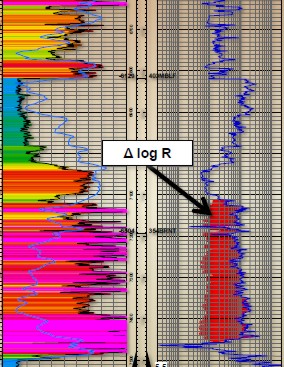  Sonic resistivity overlay showing separation in Barnett Shale, Texas,
labeled "ΔlogR" and shaded red. The high
resistivity interval is about 50% clay and 50% silt with 4 to 5%
porosity, with free gas and adsorbed gas. There is kerogen, as well
as gas, contributing to the high resistivity. The zone is also quite
radioactive , some of it due to clay but most of it due to uranium
carried by the kerogen.
Sonic resistivity overlay showing separation in Barnett Shale, Texas,
labeled "ΔlogR" and shaded red. The high
resistivity interval is about 50% clay and 50% silt with 4 to 5%
porosity, with free gas and adsorbed gas. There is kerogen, as well
as gas, contributing to the high resistivity. The zone is also quite
radioactive , some of it due to clay but most of it due to uranium
carried by the kerogen.

Raw logs showing resistivity porosity overlay. Red
shading indicates possible hydrocarbon zones. The density or
density porosity (solid red curve) is placed on top of the deep
resistivity curve (dashed red curve) Line up the two curves so
that they lie on top of each other in obvious water zones. If
there are no obvious water zones, line them up in the shale
zones. If the porosity curve falls to the LEFT of the
resistivity curve, as in Layers A and B, hydrocarbons are
probably present. Zone
"A" has never been tested and may be a "Shale Oil" prospect.

Because of poorly chosen shift
criteria, it is possible to create too much or too little
separation between the resistivity and porosity curves. This is
where the logic comes into play. If the two cureves are
"tracking" each other, then the zone is wet. Tracking means the
two curves roughly parallel each other, like railroad tracks. If
the two curves are roughly a mirror image of each other, then
they are not tracking, and separation is expected. Adjust the
shift to make this happen. The quantity of the separation is a
measure of the quality of the hydrocarbon show.
 QUANTIFYING THE OVERLAY CONCEPT
QUANTIFYING THE OVERLAY CONCEPT
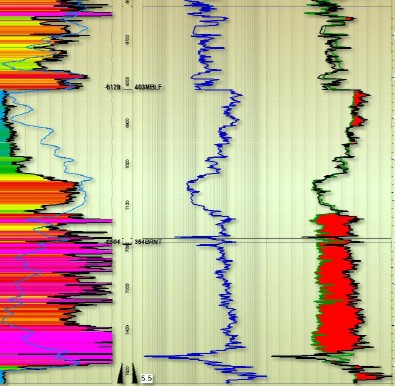 The
resistivity porosity overlay was, and still can be, made by
tracing one curve on the other, or by using a film copy of one
curve laid on the paper copy of the other. Back in the day, we
used light tables or windows so we could see through the paper.
When I traveled to the Arctic, I built a page sized light table
in my brief case. The remaining space held pencils, straight
edge, calculator, QC and analysis forms, spare socks, and
underwear. The
resistivity porosity overlay was, and still can be, made by
tracing one curve on the other, or by using a film copy of one
curve laid on the paper copy of the other. Back in the day, we
used light tables or windows so we could see through the paper.
When I traveled to the Arctic, I built a page sized light table
in my brief case. The remaining space held pencils, straight
edge, calculator, QC and analysis forms, spare socks, and
underwear.
Today, we can make these overlays
on most professional petrophysical software packages or even
with a spreadsheet program.
Original sonic
log (black curve) and calculated resistivity curve (shaded red)
showing potential source rock or, as
in this case, a gas shale (Barnett) 
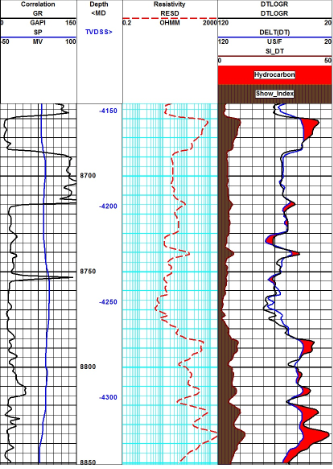
 Example of a resistivity
porosity overlay looking for bypassed pay in a limestone. The
resistivity has been transformed into a sonic log by appropriate
scaling (see below). Red shading indicates possible
hydrocarbons. The brown shaded curve is a "Show Index" - higher
values are good news.. Example of a resistivity
porosity overlay looking for bypassed pay in a limestone. The
resistivity has been transformed into a sonic log by appropriate
scaling (see below). Red shading indicates possible
hydrocarbons. The brown shaded curve is a "Show Index" - higher
values are good news..

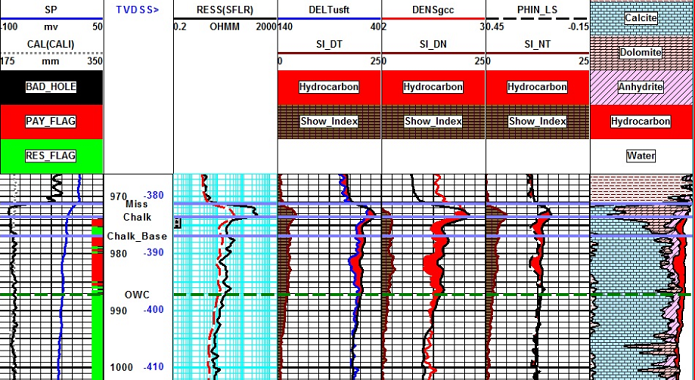
Resistivity porosity overlay
for sonic, density, and neutron (shaded red) and Show Index for
each (shaded brown) The full blown lithology porosity track on
the right shows a typical computerized analysis. More detailed
porosity, water saturation, and permeability curves would
normally be presented. Here, the objective is to locate the oil
water contact in a low permeability regime with residual oil
below the contact. The transformed resistivity sits on the
porosity curve at the base of each track (water zone) and also
in the shale zone above the oil (on sonic and neutron only).
 QUANTIFYING THE OVERLAY
QUANTIFYING THE OVERLAY
The
illustrations in the previous Section were generated by
appropriate mathematical transforms that convert the resistivity
log into sonic, density, and neutron values. This is easily done
on most petrophysical software by adjusting the horizontal scale
of the resistivity log and placing the curve in the porosity
track or vice versa. A more useful approach is to code a few
custom equations into the User Defined Equation module of your
software. This allows you to run several dozen wells in a day to
see which ones might have bypassed pay. The equations you need
are:
1: DTlogR = DT1 -- DT2 * log(RESD)
2: SI_DT = 5 * (log(RESD / RSH) + 0.02 * (DTC --
DTCSH)
3: DNlogR= DN1 -- DN2 * log(RESD)
4: SI_DN = 5 * (log(RESD / RSH) - 2.5 * (DENS --
DENSSH))
5: NTlogR = NT1 -- NT2 * log(RESD)
6: SI_NT = 5 * (log(RESD / RSH) + 4.0 * (PHIN --
PHINSH))
Where:
XXlogR = resistivity log scaled into compatible porosity log units
SI_XX = show index based on the separation between the porosity log curve
and the transformed resistivity
Default Values for Carbonates:
RSH = 4.0, DTCSH = 60, DENSSH = 2.47, PHINSH = 0.15
DT1 = 82, DT2 = 22, DN1 = 2.10, DN2 = --0.45, NT1 = 0.22, NT2 =
0.09
The
parameters assume DTC is in usec/ft, DENS is in g/cc, and PHIN
is decimal fraction porosity.
Shale base lines need to be adjusted so that the Show Index is
near zero in water or shale zones.
DT1, DN1, NT1
are adjusted so that the resistivity porosity separation is near
zero in shale or water zones.
DT2, DN2, NT2 are amplitude scale factors and seldom need to be
changed.
Default shale base lines for sand
shale sequences will be considerably higher.
The best way to find the
parameters for scaling resistivity into porosity units is to
crossplot logarithm of resistivity on the horizontal axis and
the porosity indicating log values on the vertical axis. You
need to include enough interval to see non-source rick "normal"
shales and some of the potential reservoir intervals. The data
points along the southwest edge of the data show the normal
trendline. Data points for reservoir or source rock peel off
toward the northeast of the plot area.
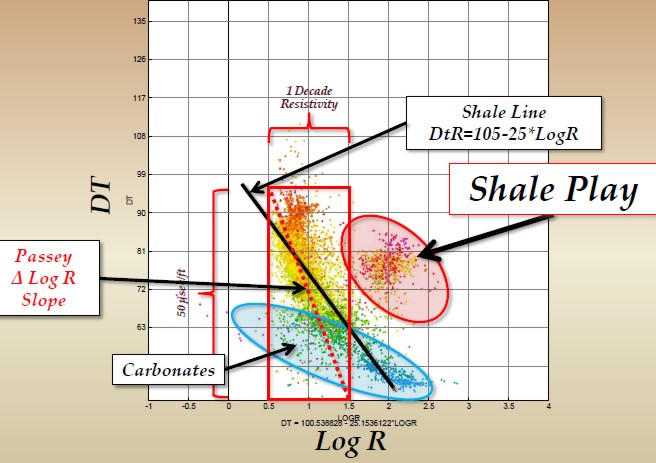
Sonic versus logarithm of resistivity (DTlogR) Crossplot showing
non-source rock trend line and reservoir or source rock clusters of data. The
equation of the non-source rock line is DTlogR = 105 - 25 log(RESD) for
this Barnett Shale example (DT1 = 105 and DT2 = 25). Similar plots
can be made with density or neutron data on the vertical axis..
|

